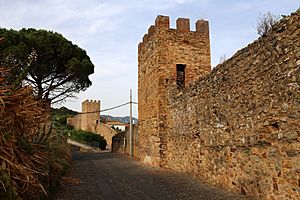Siege of Villa di Chiesa facts for kids
Quick facts for kids Siege of Villa di Chiesa |
|||||||
|---|---|---|---|---|---|---|---|
 Medieval walls of Iglesias |
|||||||
|
|||||||
| Belligerents | |||||||
| Commanders and leaders | |||||||
| Strength | |||||||
| 1,000+ several siege engines |
250 knights 272 men-at-arms 128 archers 600 townsfolk |
||||||
| Casualties and losses | |||||||
| heavy | unknown | ||||||
The Siege of Villa di Chiesa was a major battle that took place between the summer of 1323 and the winter of 1324. Villa di Chiesa is known today as Iglesias. This important fight involved the army of the Crown of Aragon (led by Alfonso IV of Aragon) and the army from the giudicato of Arborea. They were fighting against the city of Villa di Chiesa, which was controlled by the Republic of Pisa.
This siege was the very first step in the Aragonese plan to take over Sardinia from Pisa. Their goal was to create a new country called the Kingdom of Sardinia.
Contents
The Siege Begins
The siege started on June 28, 1323. The combined army of Aragon and Arborea was quite large, with over a thousand soldiers. They also had several big machines called siege engines, which were used to attack city walls.
The city of Villa di Chiesa was well-protected. It had strong defensive walls and a good number of defenders. These included about 250 knights, 1,000 other soldiers (with 128 skilled crossbowmen), and 600 townspeople who helped defend their home.
Challenges for the Attackers
The attacking army faced many problems. The weather was hot and humid, which made things very difficult. Also, a serious illness called malaria spread through their camp. This sickness made many soldiers very ill, and some even died.
Because the war lasted much longer than expected, many Aragonese soldiers decided to leave. They went back to their homes in Spain before the fighting was over. This made the attacking army weaker.
For many months, the crossbowmen defending Villa di Chiesa were very effective. They caused a lot of damage to the Aragonese army, who found it hard to get inside the strong city walls.
Cutting Off Supplies
To try and force the city to give up, the Aragonese and Arborense leaders decided to cut off all supplies to Villa di Chiesa. This meant no food or other important items could get into the city. They hoped that if the people inside ran out of food, they would have to surrender.
The City Surrenders
After eight long months of fighting and being cut off, the city finally surrendered on February 7, 1324. When the Aragonese troops entered the city, there was almost no food left. Reports say that the people inside were so hungry they had eaten mice, cats, dogs, and birds before they gave up.
What Happened Next
After taking Villa di Chiesa, the Aragonese army continued their march. Their next target was a place called Castel di Castro. On February 29, they fought another Pisan army at the battle of Lucocisterna and won. This victory helped them continue their conquest of Sardinia.
See also
 In Spanish: Asedio a la ciudad de Iglesias para niños
In Spanish: Asedio a la ciudad de Iglesias para niños

